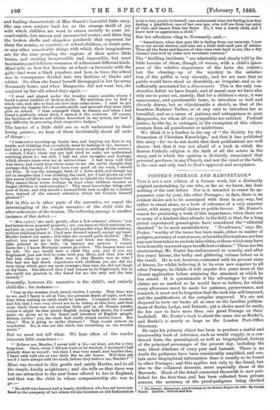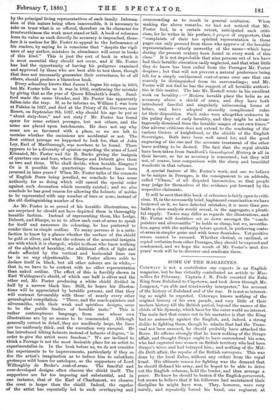FOSTER'S PEERAGE AND BARONETAGE.* Tun is not a new edition
of a former work, but a distinctly original.undertaking, by one who, so far as we know, has done nothing of the sort before. Nor is it intended to renew its ap- pearance year by year, like other Peerages ; in fact, there is an evident desire not to be associated with them in any way, but rather to stand alone, as a book of reference of a very superior order, with many special claims on public favour. Mr. Foster's reason for producing a work of this importance, when there are so many of a kindred class already in the field, is that, for a long period experienced genealogists have considered the "editorial standard" to be most unsatisfactory. "No advance," says Mr. Foster, "worthy of the name has been made, either in matter of pedigree, accuracy of coat armour, or heraldic illustrations, nor has any care been taken to exclude false titles, or those which may have been honestly assumed upon insufficient evidence." These are the shortcomings Mr. Foster has endeavoured to remedy, and after five years' labour, the bulky and glittering volume before us is the result. He is not, however, contented with its present state of fitness, for whilst believing it to be even now superior to all other Peerages, he thinks it will require five years more of the closest application before attaining the standard at which he has aimed. It is questionable if the advantages he already claims are as marked as he would have us believe, for whilst every allowance must be made for patience, perseverance, and research, it must not be forgotten that the task was self-imposed, and the qualifications of the compiler unproved. We are not disposed to turn our backs all at once on the familiar publica- tions of Burke, Lodge, and Debrett ; yet a choice must be made, for few care to have more than one great Peerage on their bookshelf. Mr. Foster's book is about the same size as Burke's, and Burke's is nearly as large as the London Post-Office Directory.
He says his primary object has been to produce a useful and trustworthy book of reference, such as would supply, in a con- densed form, the genealogical, as well as biographical, history of the principal personages of the present day, including the near blood relations of every peer and baronet. There is no doubt the pedigrees have been considerably amplified, and con- tain more biographical information than is usually to be found in other Peerages ; and this applies not only to the lineal, but also to the collateral descents, more especially those of the Baronets. Much of the detail connected therewith is now pub- lished for the first time, and has been collected from private sources, the accuracy of the proof-pedigrees being checked
• The Peerage, Baronetage, and Enightage of the British Empire for 1880. By Joseph Foster. Loudon: Nichols and 8= by the principal living representatives of each family. Informa- tion of this nature being often inaccessible, it is necessary to take on trust what is so offered, therefore on its character for trustworthiness the work must stand or fall. A book of reference loses its value as such directly its accuracy is impeached, there- fore it is useless for Mr. Foster to appeal to the forbearance of his readers, by saying he is conscious that "despite the vigil- ance of any author, mistakes in abundance will occur in books of this kind." This is just the sort of book in which it is most essential they should not occur, and if Mr. Foster has had the opportunity of having his pedigrees examined and approved by those who are best able to test them, though that does not necessarily guarantee their correctness, he of all others, should produce a blameless book.
Every schoolboy knows that James I. began his reign in 1603, but Mr. Foster tells us it was in 1602, confirming the mistake by giving that as the year of Queen Elizabeth's death. Sand- ford made the same blunder, and Mr. Foster has apparently fallen into the trap. If, as he informs us, William I. was born at Falaise in 1027, and died at the Priory of St. Gervase, near Rouen, on September 9th, 1087, why should his age be put at " about sixty-four," and not sixty ? Mr. Foster has found space for some extinct peerages, but not others, and the arms are placed upon hatchments. He does not say why some are so favoured with a place, so we are left to surmise whether the omissions are accidental or not. The first extinct peerage we happened to look for, that of John Ley, Earl of Marlborough, was nowhere to be found. There appears to be a diversity of opinion regarding the arms of Lord Kinnaird, Mr. Foster and Sir B. Burke giving the insignia of quarters one and four, where Sharpe and Debrett give them as two and three. Who shall decide, when heralds disagree?
Or is it possible the quarterings themselves have been reversed in later years? When Mr. Foster talks of the coronets of English Peers being jewelled, we conclude he has some authority for so doing which will cancel the special order against such decoration which recently existed ; and we also conclude he has good reason for allowing the helmets of nobles to be represented with any number of bars or none, instead of the old distinguishing number of five.
As Mr. Foster is so proud of his heraldic illustrations, we are surprised he should not have depicted them in thoroughly heraldic fashion. Instead of representing them, like Lodge, Debrett, and Sharpe, so as to allow each coat-of-arms to speak for itself and announce its colouring, he has preferred to render them in simple outline. To many persons it is a satis- faction to know by a glance whether the surface of the shield be gold or silver, and what the colours of the armorial insignia .are with which it is charged; whilst to those who know nothing of the alphabet of heraldry, the additional effect of light and shade afforded by the vertical and horizontal lines can be in no way objectionable. Mr. Foster allows sable to declare itself in black, but all other colours are in white,— that is, we have to be content with no other representation than naked outline. The effect of this is forcibly shown in Earl Waldegrave's shield, of which one half is silver and the other red, Mr. Foster producing a white shield divided in half by a narrow black line. Still, he hopes his illustra- tions will be appreciated by heraldic persons, and that they will contrast favourably with those of nearly every other genealogical compilation. "These, and the coach-painters and silversmiths, with their weak and spiritless designs, seem to be the public leaders of heraldic taste." This is rather contemptuous language, from one whose own illustrations are by no means to be commended. Although generally correct in detail, they are needlessly large, the lines are too uniformly thick, and the execution very unequal. He has introduced tilting helmets instead of helmets of degree, "in order to give the artist more freedom." We are inclined to think a Peerage is not the most desirable place for an artist to .experimentalise in. In the book before us, we do not consider the experiments to be improvements, particularly if they so fire the artist's imagination as to induce him to substitute grotesque wild boars for antelopes, as the supporters of Lord Willoughby de Broke's coat-of-arms. The fanciful and over-developed designs often obscure the shield itself. The supporters are far too imposing and substantial, and in one instance, that of the Earl of Charlemont, we observe the crest is larger than the shield. Indeed, the caprice of the artist has repeatedly led to such overlapping and overcrowding as to result in general confusion. When making the above remarks, we had not noticed that Mr. Foster had, to a certain extent, anticipated such criti- cism, for he writes in his preface, a propos of supporters, that "complaints of their too spirited representation in these pages can only proceed from those who approve of the heraldic representations—utterly unworthy of the name—which have during the present century been found in every work of this class." It is not improbable that nine persons out of ten have had their heraldic education sadly neglected, and that what little they do know has been culled froin the Peerages Mr. Foster despises ; but that will not prevent a natural preference being felt for a simply emblazoned coat-of-arms over one that can scarcely be distinguished from its surroundings ; and Mr. Foster will not find he has the support of all heraldic authori- ties in this matter. The late Mr. Boutell wrote in his excellent work on heraldry :—" Modern heralds place the helm as an accessory above a shield of arms, and they have both introduced fanciful and singularly unbecoming forms of helms, and have adopted absurdly complicated rules for their disposition. Such rules were altogether unknown in the palmy days of early heraldry, and they might be advan- tageously dismissed from the heraldic usages of our own times." Our adverse criticism does not extend to the rendering of the various Orders of knighthood, or the shields of the English Sovereigns. Both have been well cared for, and the good engraving of the one and the accurate treatment of the other leave nothing to be desired. The fact that the royal shields have been taken from Sandford's Genealogical History is all in their favour, as far as accuracy is concerned ; but they will not, of course, bear comparison with the sharp and beautiful woodcuts in that volume.
A special feature of Mr. Foster's work, and one we believe to be unique in Peerages, is the consignment to an addenda, called "Chaos," of all disputed baronetcies, so that people may judge for themselves of the evidence put forward by the respective claimants.
It will be seen that this book of reference is fairly open to criti- cism. If, in the necessarily brief, haphazard examination we have bestowed on it, we have detected mistakes, it is more than pro- bable a close analysis would reveal, in the aggregate, a plenti- ful supply. Tastes may differ as regards the illustrations, and Mr. Foster will doubtless set us down amongst the "coach- painters and silversmiths" he holds so cheap, but we, neverthe- less, agree with the authority before quoted, in preferring coats- of-arms in simpler guise and with fewer flourishes. Yet positive errors cannot be excused. Whether clerical, or cardinal, or copied verbatim from other Peerages, they should be exposed and condemned, and we hope the result of Mr. Foster's next five years' work will be to discover and eradicate them.



































 Previous page
Previous page